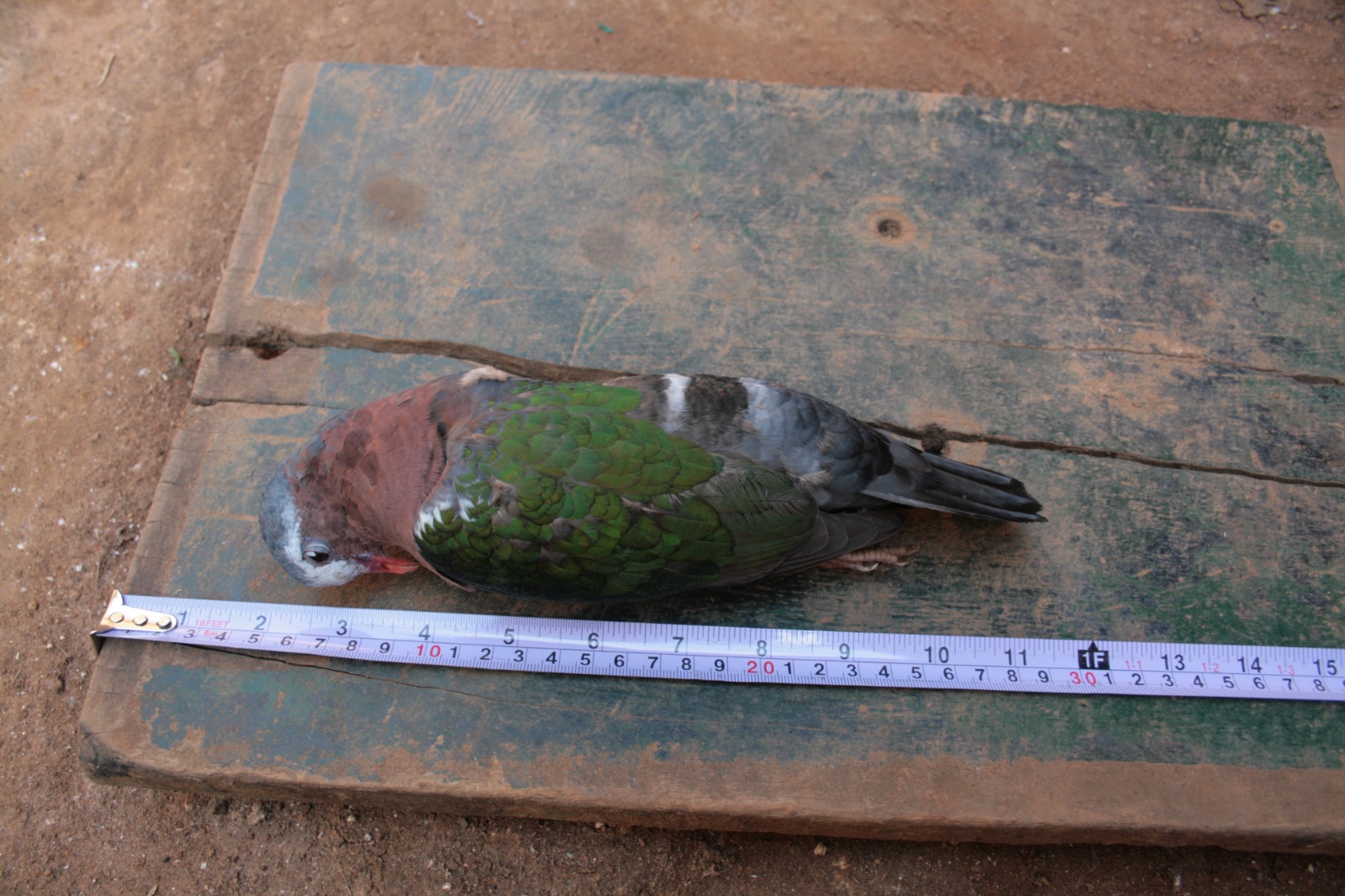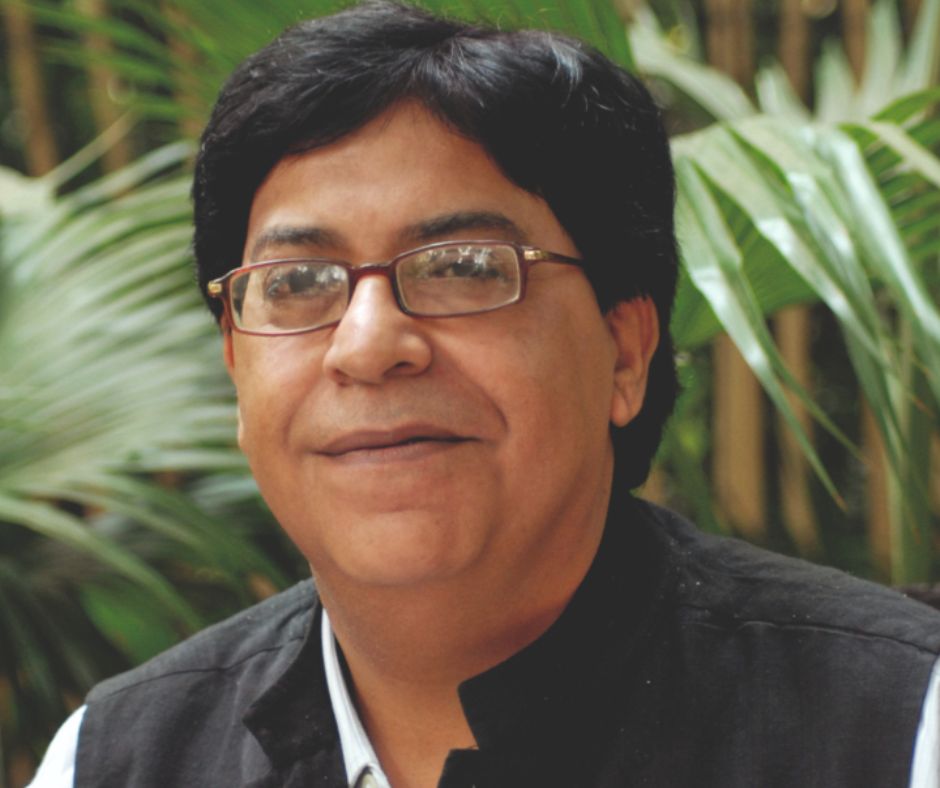
Looking at the round plate where I am served the Medu Vada, I imagine standing the empty plate on its edge and spinning it around its vertical axis, generating a sphere. However, were I to revolve it around a point on its edge, it would describe a wannabee Medu Vada as its volume would be the area of the circle of the plate (πr2) multiplied by its journeying around its circumference (2πr). Thus, the Medu Vada is 2πrxπr2 or 2πr3 akin to the formula for the Einstein Eddington Hypersphere.
In other words, while Einstein and Eddington wanted a Medu Vada, they never got one because what they generated was a horn-torus, i.e. a Medu Vada without a hole. Paying penance, I imagine them reincarnating in a traditional kitchen, cooking Medu Vadas in bulk. Reincarnated Einstein takes a dollop of slightly fermented dough of India’s ancient black lentil, whipped to beat in air bubbles and adds finely chopped onions, chillies, coconut, coriander, capsicum, salt and pepper. The dough, deftly lifted, is bounced by his pre-wetted palm into a blob pierced by his strong thumb, with a broad second phalange, and deftly deposited in shimmering oil that envelopes toroidally. At the same time, reincarnated Eddington uses a slender stick, Sikkukuchi, to easily lift it from the boiling oil and hang it above the pan to drain the excess oil under the supervision of his boss, reincarnated Subrahmanyan Chandrasekhar, the brilliant young discoverer of Black Holes whom the archetypal Oxbridge don had harassed.
Or perhaps they have reincarnated as Orthodox Brahmins of Karnataka who call vadas with holes “Tithi Vada,” implying death rituals. The centre is ominous. Sunyata. Or, as Wittgenstein would say, “Whereof one cannot speak, thereof one must remain silent.”
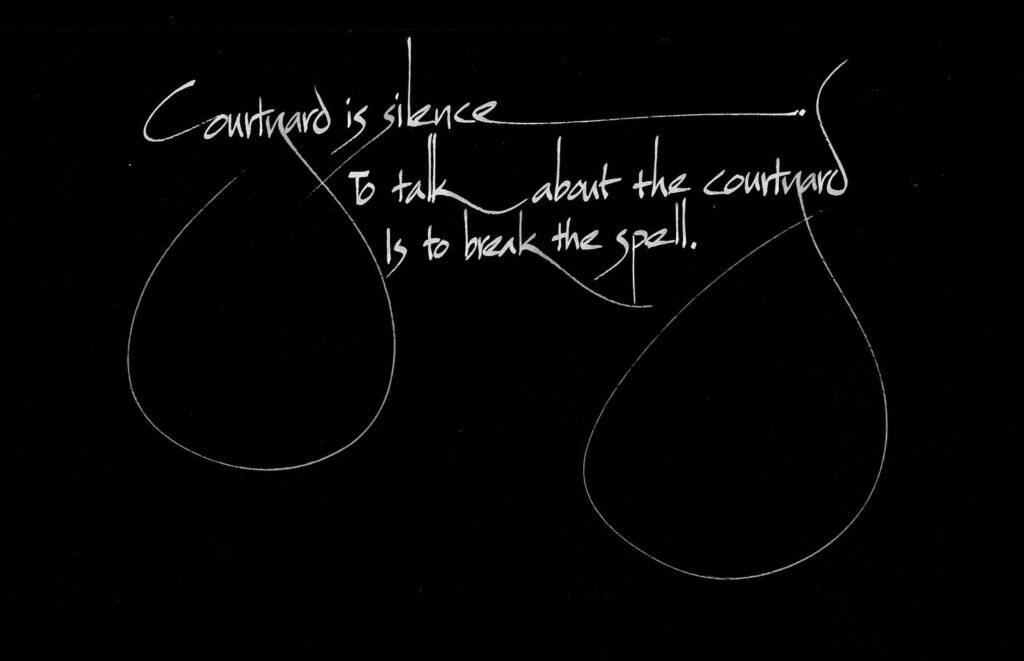
When the centre of a house is a non-house, it is a courtyard open to the sky. A house with a courtyard is a Medu vada. The courtyard, open to the sky, is the outside come home inside.
However, let us go further where Einstein and Eddington were reluctant to go. We spin the plate not about the vertical axis that passes through its centre (sphere) nor about the axis that grazes the circumference (hypersphere or horn-torus-without-a-hole), but we detach the axis of rotation from the plate and then spinning results in a torus proper or a toroidal Medu Vada! Voila!
Such thoughts cross my mind as I dig into the crackling topology of crisp Medu Vadas with their spongy core while architect Shabbir relishes his steamy, savoury Upma. We are sitting in the verandah section of Ramkrishna Restaurant, our breakfast haunt in Lonavala. It is an architecture of cognitive dissonance as the verandah is usurped sidewalk with a retractable canopy permanently un-retracted with an array of ceiling fans. The architectural identity is born of subverting building codes by occupying a legally liminal space, just as the hole at the centre of the Medu Vada is a liminal condition between outsideness and insideness.
If you think that thinking that the identity of the Medu Vada lies in its ominous absence at the centre is a wee bit obsessive, then consider this: the very act of thinking is a Medu Vada phenomenon!
Because the brain’s grid cells are neither cartesian nor polar but toroidal, the hamster of thought in the brain is spinning along the surface of a Medu Vada. The activity of the neurons lurks on the surface of a toroidal manifold, a phenomenon that neuroscientists declare is “the most influential concept in theoretical systems neuroscience,” calling it CAN (Continuous Attractor Network). Or as the unnamed protagonist in my stream-of-consciousness pseudo-bilingual novella Graceland: Chronicles through Political Uncertainties and Incorrectness blurts out the 19th line of the 3rd chapter titled “Versions” (and thus this latest iteration),
“Either you CAN
or you Kant
and if you Kan
you can-win-De”
The pun-dit embroiled the philosopher Immanuel Kant, socialist Shobhaa De and architect Achyut Kanvinde in a Hofstadterian eternal braid in the toroidal wingdings of the only extant photocopy of the novella in the safekeeping of Shabbir.

Shabbir reminded me of how once we literally fell off our chairs in Bandra’s erstwhile Gazebo Restaurant, laughing excruciatingly while reading extracts from the Graceland manuscript (the original Pomo script of the 1996 novella has since been lost; leaving its vestiges in the subtitle; thankfully, the English translation remains). The novella hovered between fiction and non-fiction, akin to the liminal condition at the centre of the Medu Vada.
However, a passage from an earlier essay I wrote as a student of architecture and published later has a more direct relationship to the Medu Vada. The essay was titled “Forms,” and I wrote it for NASA’s Akriti Journal. Someone had requested me for a piece for their Akriti publication (it must have been Rajkumar from their Editorial board). I met Raj’s deadline with my two-page typewritten essay (this was in the 80s before the advent of computers). Raj began to skim through it. I waited for him to finish. Our conversation then went something like this, reflecting the audacity of youth:
Me: I have good news and bad.
Raj: What’s the good news
I met your deadline.
So what’s the bad?
I can’t give it to you.
Why not?
It’s too good.
So?
So, I’ll send it to a foreign journal and write you another one –give me a weekend.
He did, and I did (see Collapsing Column & The Expanding Universe in An Architect Eats Chapati).
Those days, the iconic journal before that adjective was overused was the lavishly produced Mimar: Architecture in Development (“Mimar” means “architect” in Arabic). Each monthly issue had a glazed cover with a customized die-cut relevant to the cover’s picture. The magazine was headquartered in Singapore. I snail-mailed my submission. The editor said he would publish it if I agreed to drop the opening paragraph and three others. The essay had thirteen paras, each conceived independently like beads of a necklace held by a narrative thread. I replied that he could drop the three, but the opening paragraph was not negotiable. Form was published with the opening thankfully intact.
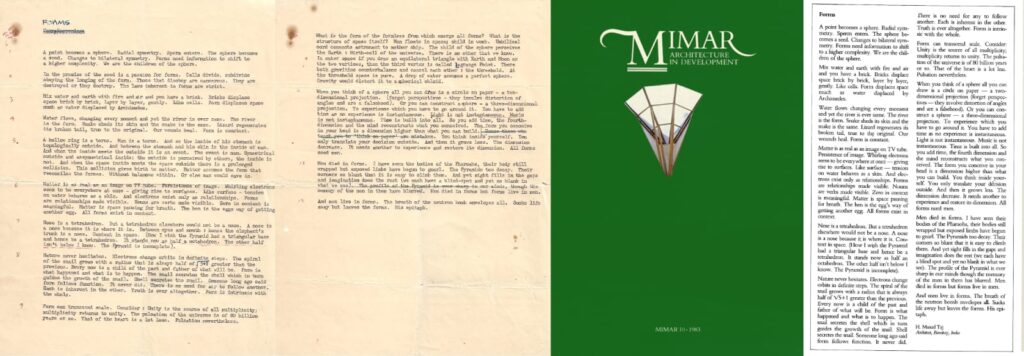
While writing this essay, I reread the missing parts, which still make sense. So I googled the editor and located him. He had retired as a Distinguished Professor of Architecture and Historic Preservation. I emailed him inquiring about his reasons for dropping them. His reply was gracious, “How time flies! It was a pleasant surprise to get your email. Forty years is indeed a long time.” But no, he could not recall.
One of the censored paragraphs concerns the implications of the torus, i.e. the mathematical name for the Medu Vada. It claimed that the inside of our stomach was outside. Before I quote it, I will share a poem that considers the earthworm as an extended torus or hollow tube.
Earthworm
Brown, that is still, is Earth,
Brown that moves is I.What travels through me is Earth,
Which travels through Earth, am I.Inside and outside is Earth,
In-between two outsides am I.Which embraces circles is Earth,
Which remains a segment, am I.All that is Earth is Earth,
All that is not, is I.
Both the Medu Vada and the earthworm reside “In-between two outsides.” So do we. For if you take the earthworm and grow hands and feet, give it a face, you could make a human being that topologically remains a torus. The alimentary canal would be the same, though convoluted. This was the paragraph that Mimar judiciously did not publish:
A hollow ring is a torus. Man is a torus. And so the inside of his stomach is topologically outside. And between the stomach and the skin is the inside of man. And when the inside meets the outside, it is an event. The event is man. Symmetrical outside and asymmetrical inside; the outside is perceived by others; the inside is not. And when the space inside meets the space outside, there is a prolonged collision. This collision gives birth to matter. Matter assumes the form that reconciles the forces. Without balance within. Or else man would cave in.
We and earthworms, Medu Vadas, and doughnuts are all topological cousins. Years later, that results in a poem with the Teacup saying:
Topologically
I am akin to a bagel
Torus with a hollowed bowl
In which you hold tea
The handle
Is my mathematical identity
Not the bowl
That holds your tea
Your thumb
Index finger
Pinch my handle
Penetrating my void
Middle finger following
The shape of my handle
Grazing the toroid
Holding meYou too are a torus
Topologically
With several dents and an axis
Extending from mouth to anus
A convoluted journey
Travelled by another torus
The bagel you bit while sipping
From a toroidal cup of tea
A trifecta of voids
Intermingling at high tea
The magazine Mimar, in which “Forms” appeared, connected me to Architect Charles Correa. He visited their office in Singapore as they were doing a book on him and came across the essay. He liked it, got my phone number from the editor and carried a copy for me back to Bombay. He called, saying we ought to meet. That’s how we first met, and our conversation continued intermittently until thirty-two years later, I spoke at The Charles Correa Remembrance, a month after he passed away.
In our first meeting, he offered me a job at his office, and I said I was on my way to the Sultanate of Oman as I had landed a job as an architect there. He said I was “daft.” Perhaps, but I got a chance to make my buildings before I turned thirty. I said I’d work with him on return and did.
Afterwards, we lost touch until my chapter on him against the backdrop of post-independence architecture, Infinity of Traces, appeared. I was then in Ottawa, and once again, he got my number and called me to say how much he liked that essay. After that, during each visit to India, we’d meet either at the Bombay Gym or in the hi-rise that he had designed, Sonmarg, where he lived with Monika and her magnificent handloom.
Charles had a mercurial mind like no other architect of his generation, and conversations with him were high-octane sessions. Only once did I tell him about something I had designed. It was the Stalintas Cube.
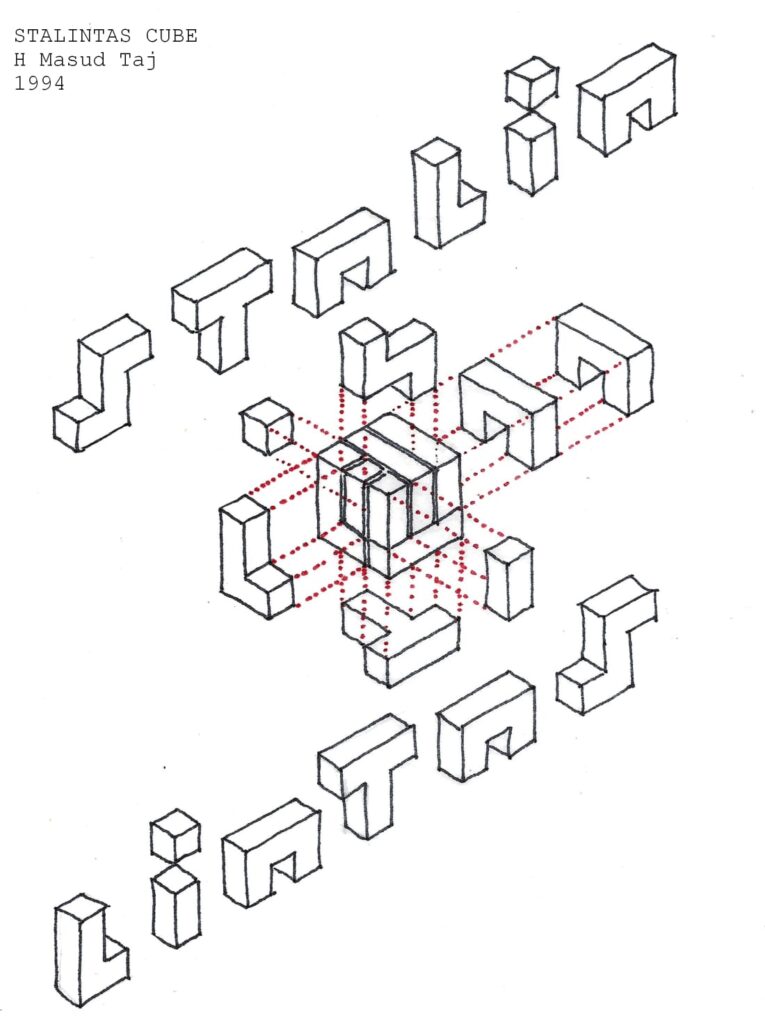
It came about because Architect Pitkar had booked the Auditorium Hall at Jehangir Art Gallery and, that year, decided not to exhibit and asked me if I’d like to. This was the early 90s when the Soviet Union collapsed, and the world turned unipolar. I had begun to obsess with the fact that while propaganda under Communism was over, it was benign compared to propaganda under Capitalism, which was far more pervasive and pernicious. In democracies, after all, consent had to be manufactured, as Noam Chomsky pointed out. One strand was the world of advertising that exploited human emotions to sell commercial products. Or as the doyen of Indian advertising, Gerson da Cunha, said, “Two things are certain in life: taxes and death. There is a third today. Advertising. There is no avoiding it.”
Hence, I rearranged S T A L I N to spell L I N T A S (the advertising wing of the multinational Hindustan Unilever) and used the anagram to interlock into a 3x3x3 cube. Charles loved it and excitedly said to Monica across the living room, “Masud found Lintas flips to Stalin!” His excitement, I suspect, had less to do with my design and more with my anagram. The calligraphic cube was a basis for an installation that both regresses and explodes into space as the cubic dot of “i” in the cube would repeat the anagram-interlock ad infinitum to emerge as bamboo grids outside the roof and walls of the gallery and hence it remained unbuilt.
When I joined his office, Charles put me in charge of the Inter-University Centre for Astronomy and Astrophysics IUCAA project in Pune that, inadvertently mapped the mother-of-all Medu Vadas in its courtyard.
I recalled Charles’s discussions with the scientists Jayant Narlikar and Ajit Kembhavi, with me acting as a translator between the astrophysicists and the architect. So, I emailed Ajit, now an Emeritus Professor. He replied warmly, “It is wonderful to hear from you after thirty years! Time indeed passes so quickly…IUCAA is in good shape, the buildings are the same, they are well looked after…The old times were indeed wonderful, with all the discussions, planning and creativity. We miss all of you, and particularly Charles very much…”

At the Inter-University Centre for Astronomy & Astrophysics (IUCAA) in Pune, the courtyard kund did not quite convey what the critic Charles Jencks observed: “a Black Hole…with energy being ejected on the diagonal.” However, the architectural detailing of the boundary bordered on the cosmic, which I relished in my essay on him.
To relieve the dullness of the local basalt stone in constructing the two swerving walls between which you arrive at IUCAA, Correa had it capped with black kuddapah stone and culminating courses of black polished granite. The resulting ‘Black on Black’ aesthetic, with the smoothening out of the texture from coarse-basalt, matt-kuddapah, to mirror-granite, is a precursor of the night-sky unravelling the true colour of the universe. The meandering walls of IUCAA, with their brooding intensity during the monsoon, with their gradations of accelerating darkness, express the metaphysics of an architectural brief as scarcely any other wall in modern India.
The Black Hole, resurfaced in my novella Graceland. Those days as a visiting professor of Structures at Pillai College of Architecture in New Mumbai, I had lectured on the limitations of simply supported beams via the backbone of ever-elongating Dachshunds:
06.11 The growth of the Dachshund is in the wrong direction. No matter how far he extends himself, bearing backaches with the equanimity of a backpacker, he yet remains as vertically challenged as before.
06.12 Orientations matter.
06.13 Dachshund is lateral thinking gone literal. Leads to collateral damage.
06.14 Dachshund that wishes to go beyond lateral thinking sits astride the Schwarzschild Radius with his face and fore-limbs out and his extended body aft-limbs and tail sucked into the void tail-first, while the head remains out, with eyes bulging with awe, and forelimbs scrambling at the conceptual boundary. For a brief and shining moment, it is the most elongated Dachshund in the universe. But the moment is very, very brief, and there is a certain finality about the shine. Even as the tail hits singularity, the rest of the Dachshund descends in haste as it collapses unto itself. Imploding-eternal-darkness follows brief-and-shining-moments.
But perhaps The Shining will continue. The torus is a self-organizing system that comes together as a unity. For instance, the heart is the first organ to develop in the womb, generating a toroidal ECG and MCG field; you’ll see the torus in sections of apples and oranges; in the flow of the oil enveloping the Medu Vada batter as you deep fry; in the toroidal signatures of each vowel you enunciate and, as your head is hotter than your feet, in the micro toroidal convection air currents so that your whole body is enveloped in a torus of air; in tornadoes that spin at 300 km/hr around an unblinking eye of the storm as well as the way the whole atmosphere moves; in the electromagnetic field surrounding the earth on its surface as well as the toroidal magnetosphere of Jupiter that is the largest known continuous structure in our solar system (after the one around the sun). Further afield a torus of thick dust and accretion disc surrounds supermassive black holes like in the heart of the spiral galaxy NGC 4388 in the constellation Virgo.
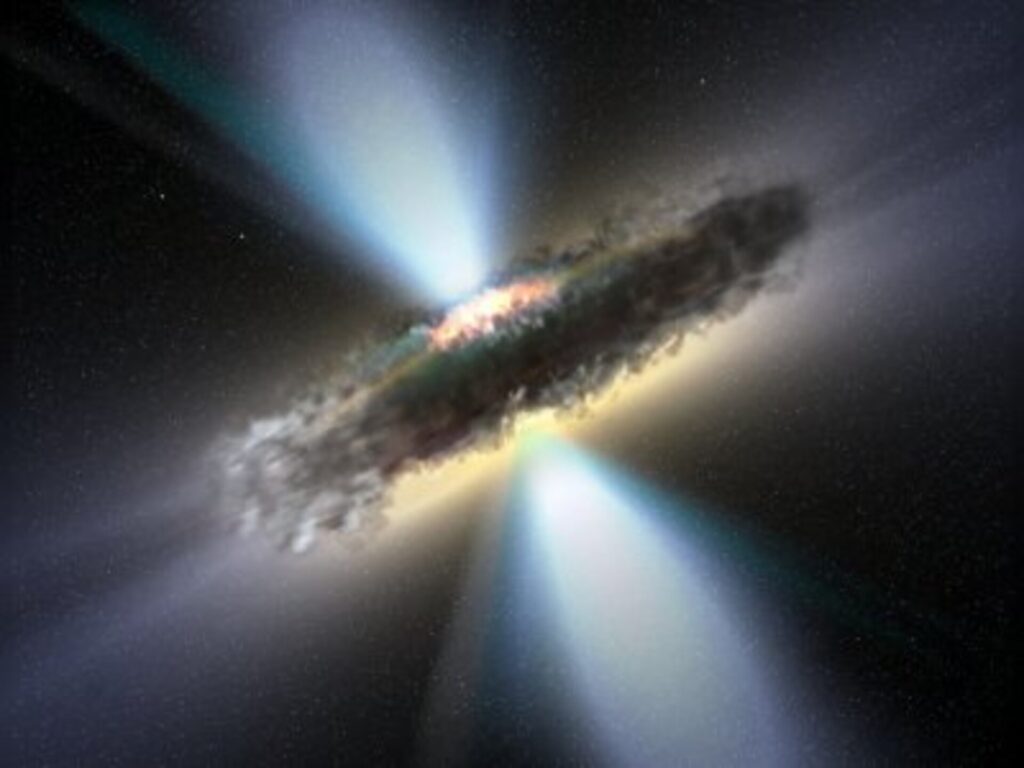
As it Medu Vada within Medu Vada all the way, asserting the unity of all existence, if indeed the whole universe is toroidal, then what stops the black hole from being a torus, too, with ingested stuff spewed almost instantaneously on the other side as it safely crosses the unpronounceable Dlihcszrawhcs Radius? “As above so below,” thus spake Hermes Trismegistus (Graceland 3:52). What the Medu Vada suggests is that there is hope for all of us yet, for all architects, Dachshunds, Johnnyyyy! and other denizens of our fleeting and fleeing Universe.
In 1971, physicist Stephen Hawking suggested that “the Big Bang created mini” black holes. That led Coyne and Cheng to conclude in 2009 that micro blackholes were the fabric of the universe, while confessing they didn’t quite know how the reduced-Planck-mass black hole would behave. What if a mini-micro blackhole once lurked in each of us and evaporated (as they all do) before it could swallow us?
Planck Poem
h equals ten raise to the 27th part
Of six point sixness, so
You can’t push electrons
Into orbits lesser, though
You confine man
With continues
Electronfreedom
Author’s Note: Gardner, R.J., Hermansen, E., Pachitariu, M. et al. Toroidal topology of population activity in grid cells. Nature 602, 123–128 (2022). Coyne, D. G., & Cheng, D. C. (2009). A Scenario for Strong Gravity in Particle Physics: An alternative mechanism for black holes to appear at accelerator experiments. ArXiv. /abs/0905.1667. Jencks, Charles The Architecture of the Jumping Universe London: Academy Editions 1996 p. 136. Planck Poem was composed in 1981 when the constant was measured in ergs: h=6.626×10^-27ergxsec. The poem Worm is from a 100-poems ms titled Animalia: The Animals Within Us, and the poem Teacup is from a 100-poems ms titled The Metaphysics of Things. The long poem Domain Of Inbetween, and the essay Forms, can be downloaded from Academia.


